23 Trees with Red Berries – Identification Guide with Pictures and Names
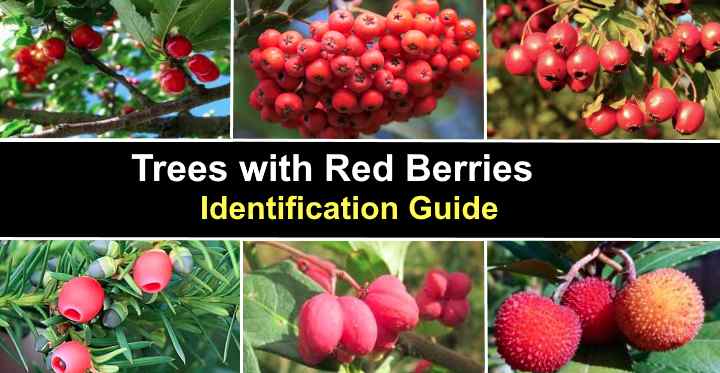
Red berries that grow on trees add a dash of color to any garden. Trees with edible red berries have the bonus of providing tasty, healthy fruits. After all, who can resist eating sweet red cherries? However not all red berries are edible, and it’s essential to distinguish between edible red berries and poisonous berries.
There are many reasons to have trees in your backyard that produce red berries. Very often, the scarlet-colored berries appear in winter when gardens and yards may lack color. The bright red colors contrasting with dark green foliage can help brighten up your yard.
Another reason to have edible red berries growing in your garden is that they are incredibly healthy. Apart from having a great taste, red berries that you can eat are packed full of antioxidants. You can eat them straight off the tree or use them in salads, desserts, or cereals. You may also come across red berries while walking in woodlands, forests, or other open spaces.
Red Berries on Trees – Proceed With Caution
It’s important to remember that some types of red berries are extremely poisonous. So, you need to identify the exact species of berry before eating them. If you have any doubts, you should avoid eating red-colored berries that you cannot identify.
In this article, you will learn about the many types of trees that grow red berries. Pictures, descriptions, and the scientific names of these types of fruits will help identify the trees where fiery red-colored berries grow.
Red Berry Tree Identification
To identify the type of red berry tree, you should take note of the shape of its leaves, flowers, type of trunk, and size of the tree and its shape. Another way to identify the kind of red berry tree is by the berry itself.
Red berries are found on both evergreen types of trees and deciduous trees. There are some red berry-producing trees such as cherry trees and hawthorn trees that most people have heard of. Both types of these trees produce sweet or sour edible berry-like fruits.
Types of Trees With Red Berries (With Pictures) – Identification Guide
Let’s look in more detail at many kinds of trees that produce red berries.
Pin Cherries (Prunus pensylvanica)
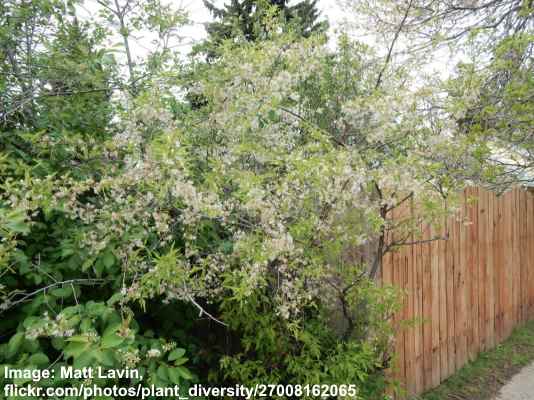
Pin Cherry (Prunus pensylvanica)
The pin cherry is a small tree with pointed leaves that produce red berries in late summer or early fall. The tree grows to between 16 and 98 ft. (5 – 15 m) in height and can be identified by its round-topped crown, and its lanceolate leaves that grow alternately on long reddish thin stems.
The edible sour small red berries can grow up to 0.31” (8 mm) across and contain a single seed.
Pin cherries also have the names bird cherries, red cherries, or fire cherries.
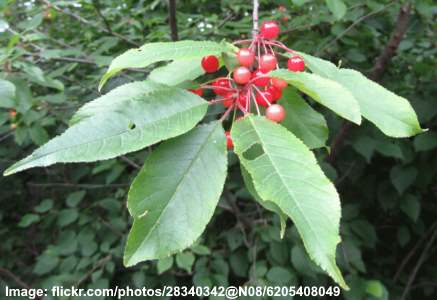
The small red edible pin cherries grow on a small tree or large shrub
You can often find pin cherry trees growing along river banks and in parks.
Red Cherry Trees (Prunus)
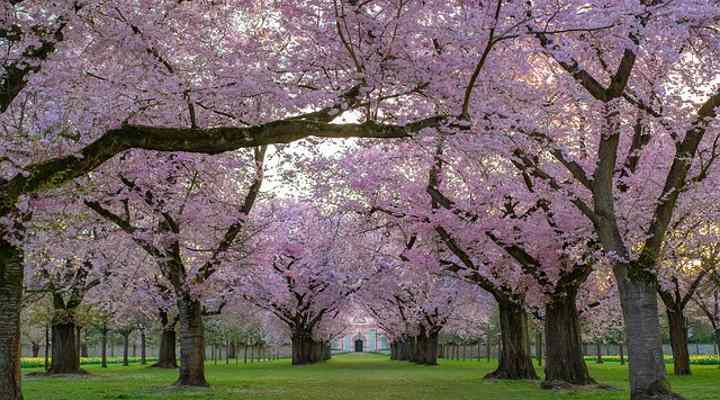
Cherry trees
Many types of cherry trees in the genus Prunus, produce stunning spring blossoms and delicious red edible fruits. There are many different types of cherries ranging in taste from sour to sweet. They can also be yellow, red, crimson red, or deep red colors.
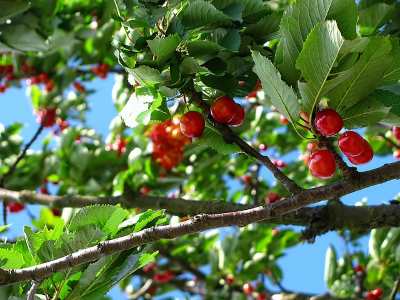
During summertime, cherry trees produce various edible cherries that range in color and taste
Although botanically speaking red cherries are a type of drupe, many people class cherries on their list of most popular tree berries.
Cornelian Cherry Dogwood (Cornus mas)

Cornelian cherry dogwood tree (Cornus mas)
Cornelian cherry dogwood is a small flowering tree or medium to large deciduous shrub with tiny yellow flowers, green oblong leaves measuring up to 4” (10 cm) long and 1.5” wide, and red berries. The tree grows to between 16 and 40 ft. (5 – 12 m) in height.
Dogwood trees are native to countries in Southern Europe and Southwestern Asia.
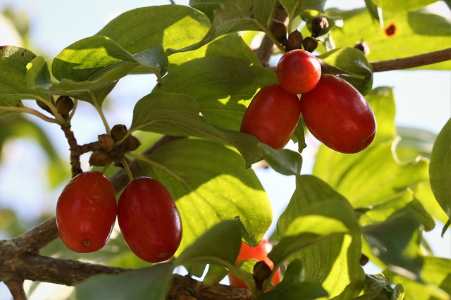
Cornelian Cherry Dogwood (Cornus mas) is a large shrub or a small tree with edible red berry-like fruits
After the small yellow flowers finish blooming, red edible fruits appear. Although the fruits look like large red berries, they are drupes similar to cherries. The shiny red dogwood berries have the shape of coffee beans. When ripe, they taste like a cross between cranberries and sour cherries.
Peruvian Pepper (Schinus molle)
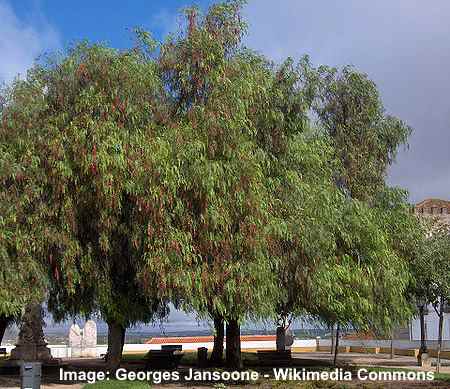
Peruvian pepper tree (Schinus molle)
Peruvian pepper is an evergreen red berry tree that can be identified by its pinnate fern-like leaves, small white flowers, and small dark red berry-like fruit with peppery red or pink woody seeds.
The small red Peruvian pepper berries have a peppery taste. The berries grow in large clusters and can grow on the tree all year long.
Growing to 50 ft. (15 meters), other names for Peruvian pepper tree include American pepper, false pepper, or the California pepper tree.
The red fruits of the Peruvian pepper tree are considered safe for consumption. However, young children may experience stomach upset after consuming the fruits.
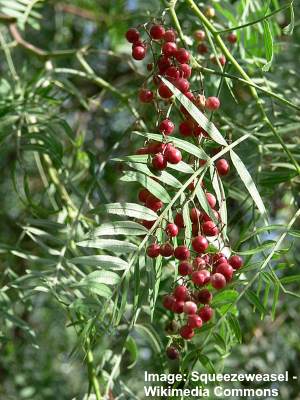
Peruvian pepper tree produces red berries with peppery taste
The pepper tree grows in hot arid climates and can be found in Florida, Texas, California, Arizona, and Louisiana. Other countries where this species of pepper tree grows are Peru, South Africa, and Australia.
Hawthorn Trees (Crataegus)
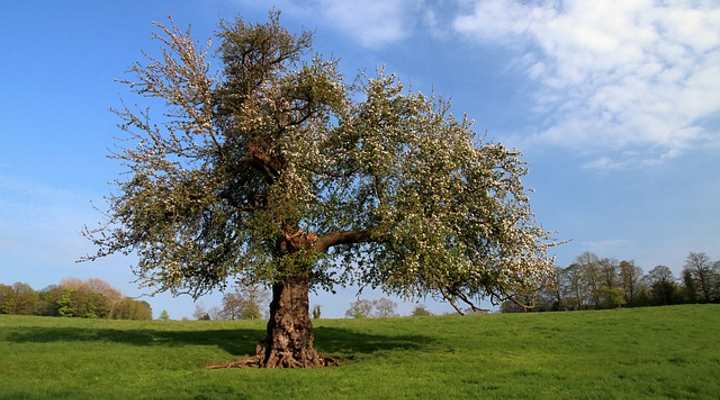
Hawthorn Tree (Crataegus)
Hawthorns are small trees with thorny branches that produce red berry-like fruits. Other common names for the hawthorn tree are hawberry, quickthorn, thornapple, and mayhaw. Hawthorns are thorny trees that grow in many countries that have a temperate climate. Depending on the species, hawthorns grow between 15 and 35 ft. (4.5 – 10.5 m) tall.
The identifying features of hawthorns are short trunks, branches that spread out and leaves arranged spirally on the shoots. Although the tree’s red fruits look like berries, they are a type of pome. So, the fruits more resemble tiny miniature apples than being a true berry.

Hawthorn trees produce edible berry-like fruits but the seeds are toxic
The red berry-like fruit from hawthorn trees look like clusters of small, round berries that appear from fall until winter. Hawthorn fruits have thick red skin covering creamy-yellow flesh. The fleshy, tangy fruit has between one and five stones in the middle, resembling small peach or apricot stones. You can eat hawthorn berries, however similar to apples, the seeds can be toxic and you shouldn’t eat them.
Hawthorn fruits grow between 0.5” and 1” (1.2 – 2.5 cm) in diameter. The fruits are edible; however, hawthorn fruit (including mayhaws) are notoriously sour and too tangy for most people. Hawthorn jams and jellies such as mayhaw jelly are the most common way to consume these fruits.
American Holly Tree (Ilex opaca)
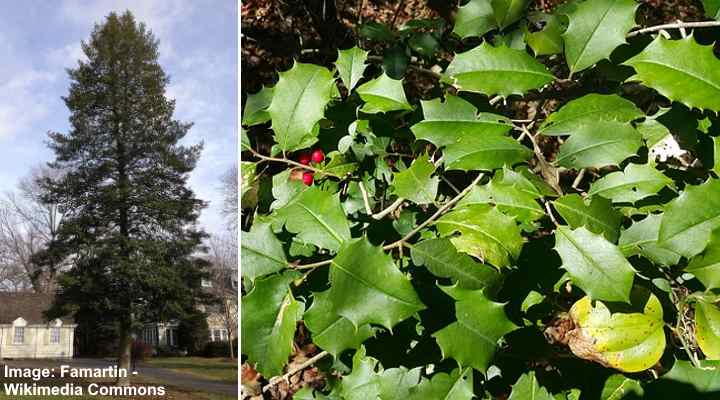
American Holly Tree (Ilex opaca)
The American holly is a tall tree with dull, dark green leathery leaves with spiny margins and small red berries appearing in the fall. The American holly tree is often used for Christmas decorations, hence is also called the Christmas holly, and has an open, pyramidal shape.
The American holly is a large evergreen tree that can grow up to 98 ft. (30 m) tall. The jaggy glossy leaves stay green all winter and the toxic red berry-like fruit adds color when little else is growing in the gardens and parks.
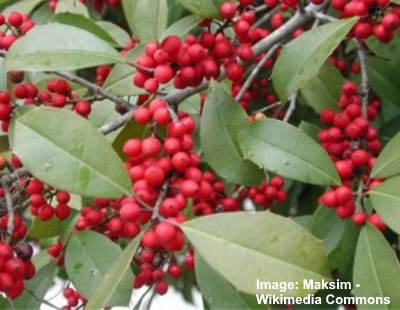
American holly is a large tree that has red poisonous berries
American holly tree berries are shades of orange to red and grow among the evergreen foliage from September until February. Like with other types of red berries from plants in the genus Ilex, they are toxic to humans and shouldn’t be consumed.
Sumac Trees (Rhus)
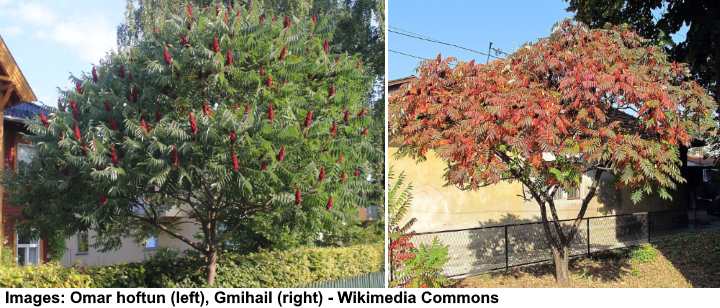
Staghorn sumac tree (Rhus typhina)
Sumac (genus Rhus) is a group of flowering small trees and shrubs. Sumac trees such as the staghorn sumac (Rhus typhina), smooth sumac (Rhus glabra), and fragrant sumac (Rhus aromatica) produce edible red berry-like drupes. Although they look like berries, sumac fruits are drupes—fruits with a seed in the middle like a peach or apricot.
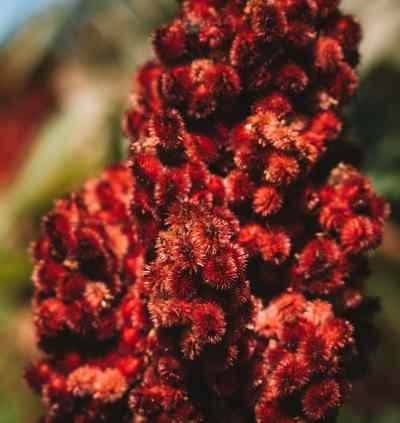
Red berry like fruits of sumac trees
The red berry-like fruits of sumac trees grow in large cone-like clusters. Each small red sumac fruit measures 0.16” (4 mm) across. The sumac berries have characteristic fine hairs, giving the red drupe a fuzzy appearance. The clusters of crimson-red sumac fruits grow up to 12” (30 cm) long.
Other identifying features of sumac trees are their fern-like pinnate leaves, conical clusters (panicles) of white or green flowers, and brilliant autumn foliage with shades of red, orange, or purple.
The red sumac drupes have a citrusy flavor with a distinct tangy taste and are high in vitamin C. Sumac berries are also used to create sumac spice, popular in Middle Eastern cuisine.
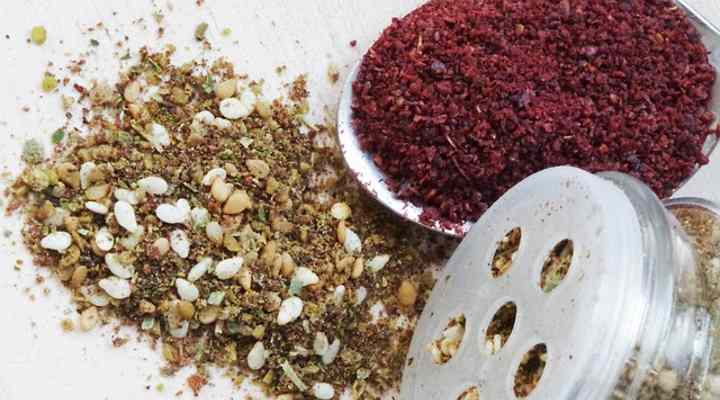
The red sumac spice is mainly cultivated from the Syrian sumac (Rhus coriaria) and is commonly used in Middle Eastern cuisine and other spice mixtures such as za’atar
Mulberry Trees (Morus)
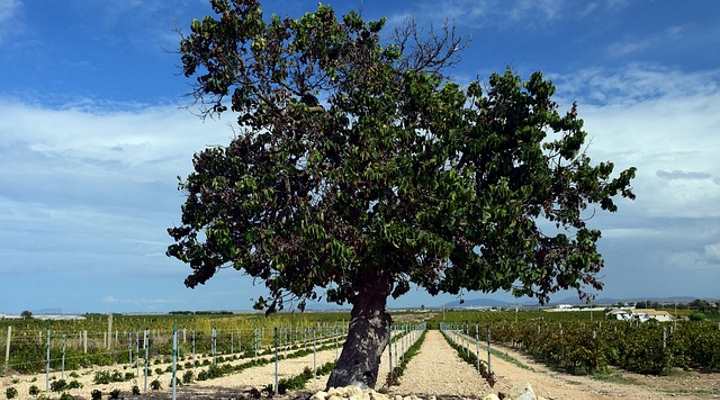
Old mulberry tree
Mulberry trees are popular deciduous trees that produce delicious edible white, red, or black berry-like fruits. Commonly called mulberries, the medium-sized, berry-producing trees have attractive heart-shaped leaves, spikes of tiny white flowers (catkins), and thick grayish-brown bark.
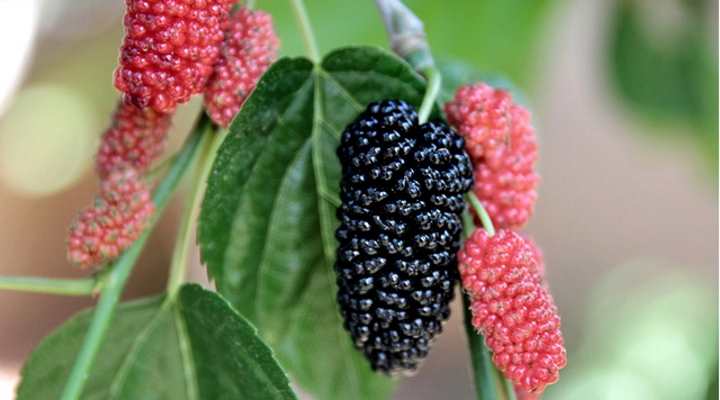
Mulberry berry-like fruit turns from red to black-purple when mature
Mulberries can be eaten fresh, and are suitable for making jellies, jams, pies, or tarts. Additionally, the mulberry berries attract plenty of birds to your summer garden.
The common species of mulberry trees are red mulberry (Morus rubra), white mulberry (Morus alba), and black mulberry (Morus nigra). They thrive in USDA zones 4 through 9, in full to partial sun, and well-drained soils. In addition, the mulberry tree is relatively resistant to pests and disease.
The mature size of mulberry trees depends on the species. White mulberry is the tallest at 80 ft. (24 m), and the common red mulberry grows up to 70 ft. (21 m). The black mulberry is the smallest species, with a height of around 30 ft. (9 m).
Additionally, there are many mulberry cultivars, such as the weeping mulberry tree (Morus alba ‘Pendula’), fruitless mulberry tree, and dwarf mulberry tree which is ideal for containers, and grows 2 to 6 ft. (0.6 – 1.8 m) tall.
Yew Trees (Taxus)
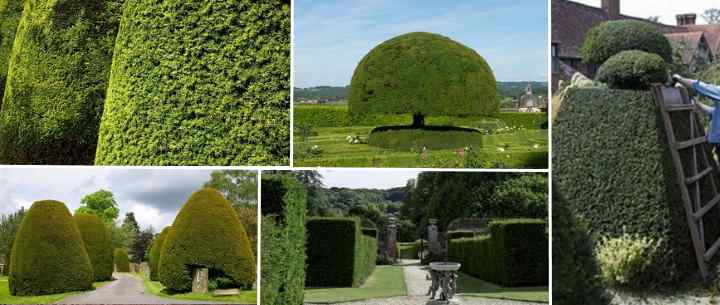
Yew trees, which have dense evergreen foliage, love pruning and are a great as privacy hedge or for topiary
Yew is a genus of slow-growing coniferous evergreen trees and shrubs that produce small red berry-like fruits. Yews are identified by their thin, scaly brown bark, tiny single-seed cones, red fruits, and linear flat leaves. The English yew (Taxus baccata) is the most common species. But Irish yew, Western yew, and Japanese yew are also ornamental conifer trees.
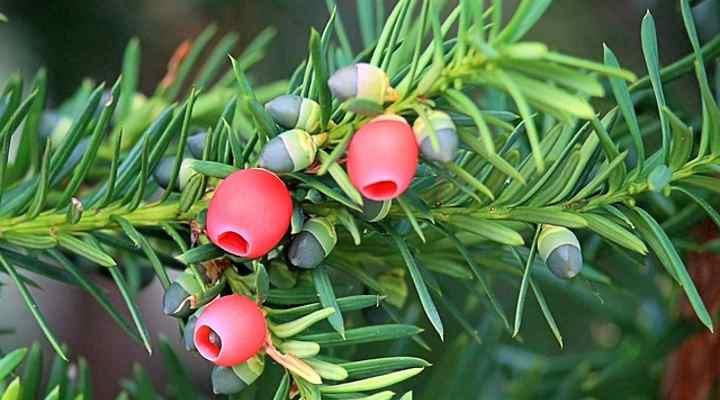
Yew leaves and mature and immature fruit
An identifiable feature of yew trees is their red berry-like fruits called arils. These cup-shaped fruits contain a single poisonous seed. The fleshy-red aril is the only part of the yew plant that is edible. Unlike most species of conifers with seed-bearing cones, yew fruit and seeds grow directly on the stems, not in cones.
Yews are cold-hardy evergreen trees that thrive in USDA zones 3 to 7. Yews can grow in temperatures as low as -13°F (-25°C); however, the shade-loving trees don’t perform well in prolonged hot temperatures. Ensure that the ground is well-draining and protect yew trees from heat, drought, and full sun for more than six hours a day.
Further reading: Yew Trees: Types, Berries, Leaves – Identification.
Spindles (Euonymus europaeus)
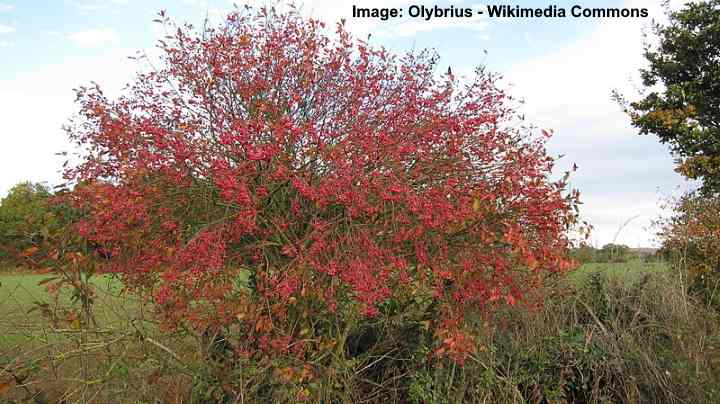
Spindle tree (Euonymus europaeus)
The spindle is a small tree or large shrub that produces showy pinkish-red berries in the fall. The identifying characteristics of the spindle tree are its lanceolate leaves with serrated margins, irregular crown, showy fall fruit, and stunning yellow fall colors. The attractive landscape tree grows 12 to 20 ft. (3.6 – 6 m) tall and up to 16 ft. (4.9 m) wide.

The unusually shaped red berries of spindle trees/shrubs are toxic and should not be ingested
Each small reddish berry of the spindle tree contains tiny seeds encased in an orange aril, similar to a pomegranate. The unusual inedible red berries have four lobes, giving them a bumpy appearance. They split open in the fall to reveal the orange seeds.
Although they look attractive, the showy red berries are poisonous and should not be consumed. Despite producing poisonous red fruit, spindle trees are popular for foundation planting, deciduous hedge, or planting as a specimen tree.
Evans Cherry (Prunus cerasus ‘Evans’)
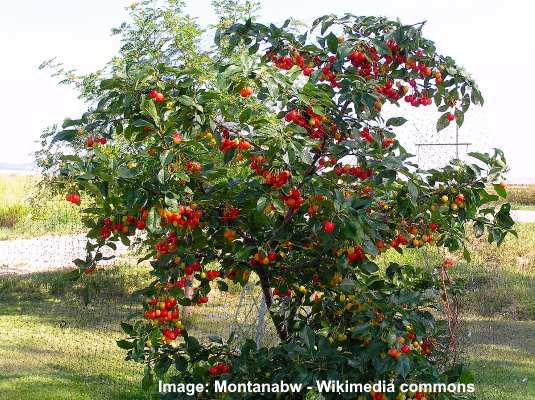
Evans cherry is a small tree that produces edible sour red berry-like fruit
The bright red berry-like fruit helps to identify the Evans cherry tree in mid-summer. The vibrant red cherry fruits are a type of sour cherry growing in dangling clusters on the small tree. Like all types of cherry, the red fruits have a large stone in the center. The tart taste of the shiny red drupes makes them ideal for use in cherry pies or jam.
Also called ‘Bali,’ Evans cherry trees are smaller than other types of sour cherry trees. The attractive deciduous tree grows 12 to 14 ft. (3.6 – 4.2 m). The cold-hardy tree thrives in freezing climates and thrives in USDA zone 3.
Apart from the attractive and tasty red berries, these trees are perfect for garden landscapes. The trees bloom in early spring with spectacular displays of white cherry blossoms emerging from pink buds. These showy blooms fill the air with sweet aromas. Next, the masses of white flowers develop into large glossy red drupes in mid-summer. Then in the fall, the dark green leaves turn to stunning shades of yellow.
Strawberry Tree (Arbutus unedo)
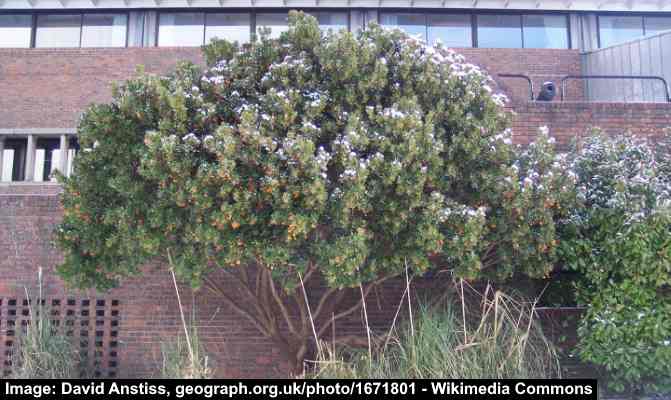
Strawberry Tree (Arbutus unedo)
The strawberry tree is a small evergreen tree that grows between 6 and 15 ft. (1.8 – 4.5 m). The ornamental tree is identified by its unusual spiky red fruit, fragrant bell-shaped white flowers, and peeling gray-brown bark. The glossy green leaves grow on reddish stems.

The evergreen strawberry tree has red spiky edible berries
Spiky red berries are an unusual identifying trait of the evergreen strawberry tree. The spherical red berries have a rough surface and have a pleasant, sweet taste. The berries range in size from 0.3” to 0.8” (7 – 20 mm) and are ripe for eating in the fall, just when the plant begins to blossom again.
The unusual red berries from the strawberry tree have a subtle aroma like anise. Biting into the strawberry fruit reveals a sweet, tangy flavor reminiscent of mango, peach, and apricot. The berries emerge yellow and turn red as they ripen. However, the sweet red berries are usually made into jams, jellies, and sauces due to their gritty texture.
The tree is suitable for growing in USDA zones 7 – 10.
Rowan Tree (Sorbus)
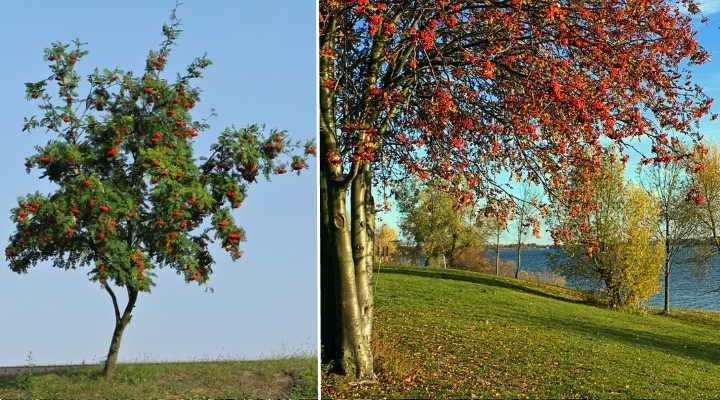
Rowan tree (Sorbus)
The rowan tree is a small ornamental flowering tree that is known for its clusters of white spring flowers followed by colorful small red berries in the summer.
The identifying features of rowan trees are their pinnately compound leaves, flat-topped clusters of white flowers, and showy red berries. Rowan trees grow between 10 and 30 ft. (3 – 9 m) tall. Their compound leaf leaflets grow alternately on stems, and white spring flowers give way to brightly colored red berries.
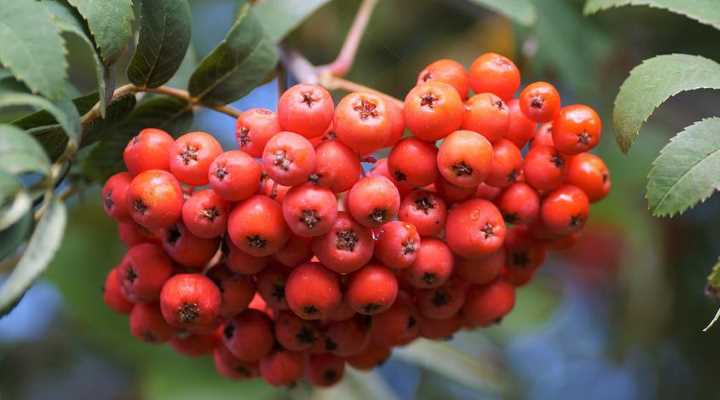
Red Berries of Rowan Tree
The bright red berry-like fruit of rowan trees measure 0.25” (6 mm) and grow in dense clusters. Rowan berries ripen in late summer or fall and persist on the tree until winter.
Although called a berry, rowan tree fruit is a type of pome or accessory fruit. The small round red berries grow densely in clusters, and their vivid colors stand out against the dark foliage.
Rowan tree berries are edible. However, rowan berries have a naturally bitter taste and are unpalatable eaten straight off the tree. Additionally, raw rowan berries are slightly poisonous and must be cooked to break down the acid. Typically, rowan berries are made into delicious jellies.
Buffalo Berry (Shepherdia)
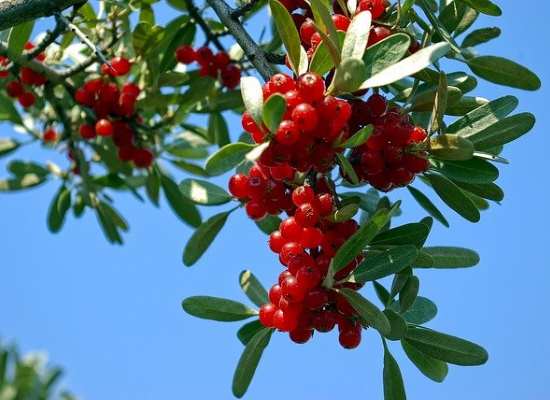
Buffaloberry (Shepherdia) produces edible sour-tasting red berries
The Buffalo berry is a small tree that can be identified by its attractive narrow, oblong leaves, thorny branches, and pea-sized, bright red berries. The green leaves contrasting with the red-colored fruit make the thicket-forming plant a beautiful background plant, security hedge, or specimen plant.
Buffalo berry is a dark red fruit with a rough texture and a sour taste. The clusters of red berries have identifiable tiny white dots on them. The red fruit grows abundantly on the buffaloberry plant, a large deciduous shrub or small tree that grows 8 – 10 ft. (2.4 – 3 m) tall.
The sour-tasting bright red berries are typically used in making jellies, jams, or pies.
Red Elderberry (Sambucus racemosa)
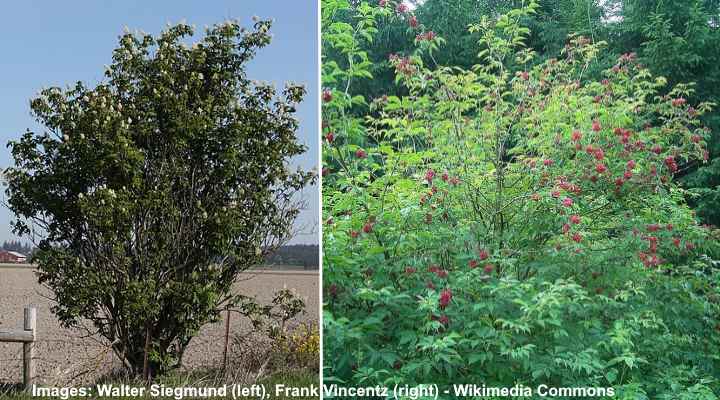
Red Elderberry (Sambucus racemosa)
In the landscape, the red elderberry plant is a tall shrub or small tree growing 7 – 20 ft. (2 – 6 m) tall. The multi-stemmed tree is identified by its pinnate-compound leaves containing five to seven leaflets. The clusters of flowers grow in a characteristic dome shape, followed by dark red elderberry fruits.
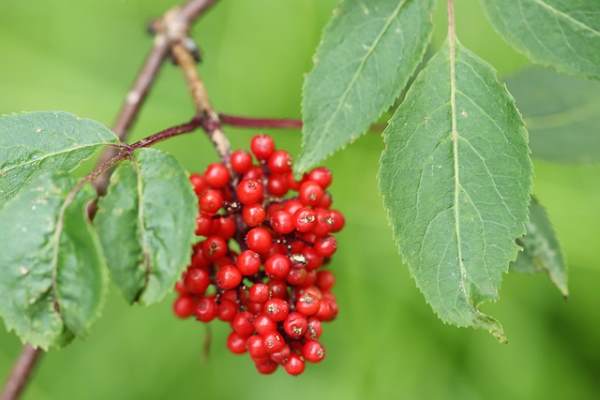
The small red elderberries should not be eaten raw and must be cooked first
Clusters of bright red fruit are the identifying feature of the large red elderberry treelike shrub. The tiny round red berries grow in dense clusters and add attractive bright red colors to the shrub in the summer and fall. The bunches of little red fruits follow clusters of lemon-scented white flowers.
Also called the red-berried elder, other species of the tree / shrub produce black or white small round berries. Although red elderberries are safe to eat after cooking, you should never eat them raw. Ingesting the tiny red berries can cause discomfort.
Allegheny serviceberry (Amelanchier laevis)
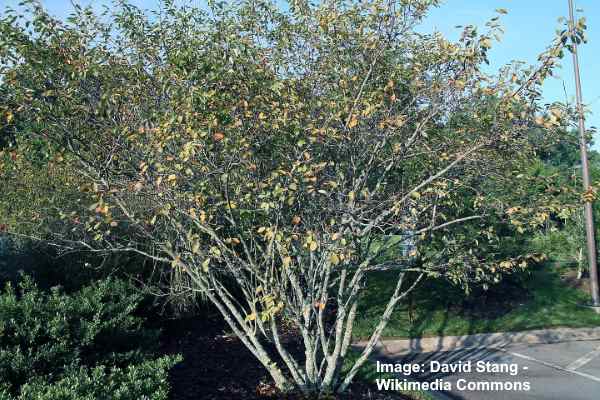
Allegheny serviceberry (Amelanchier laevis) tree
The Allegheny serviceberry is the tallest native tree in the genus Amelanchier. The distinguishing feature of the Allegheny serviceberry is its hairless leaves that emerge purple before turning green. In the fall, Allegheny serviceberry trees turn golden-yellow to warm red.
Allegheny serviceberry has smooth, gray bark with white stripes running longways. As the serviceberry matures, the gray bark becomes darker and rougher with some fissuring. Its brown or copper stems produce ovate leaves, pretty, fragrant white flowers.
Allegheny serviceberry has small round edible fruits that turn from red to purple as they mature. Compared to other varieties of serviceberries, the Allegheny serviceberry fruit is the sweetest and tastiest.
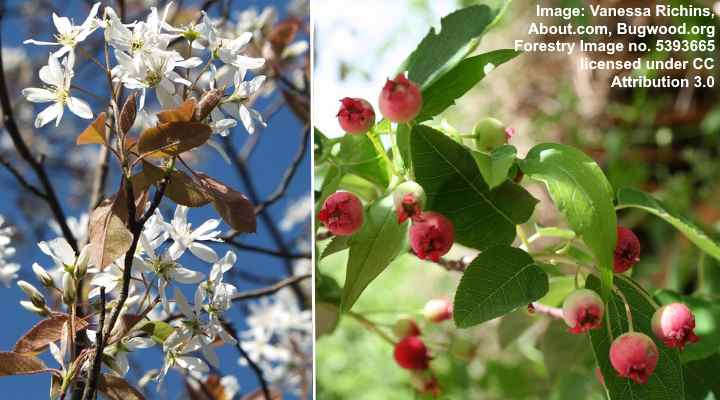
Allegheny serviceberry flowers, leaves and fruit
Due to its hairless leaves, the Allegheny serviceberry goes by the name smooth serviceberry, smooth shadbush, or smooth-leaved serviceberry.
Allegheny serviceberry trees thrive in USDA zones 4 to 8. The Amelanchier laevis species is shade tolerant and grows well in dappled sunlight or full sun.
Juneberry (Amelanchier lamarckii)
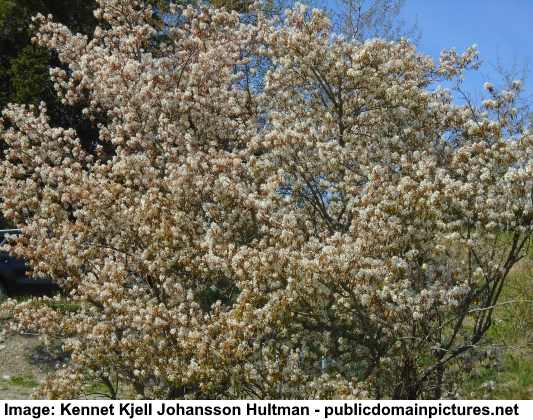
Juneberry (Amelanchier lamarckii) tree
Juneberry is also called snowy mespilus, and it’s a small tree with a spreading, vase-shaped crown. Small clusters of white five-petaled flowers appear along with the leaves in early spring. The dark-green, finely serrated ovate leaves turn spectacular shades of orange and red in the fall. The edible berries appear in June and are reddish when immature but they turn purple when they mature.
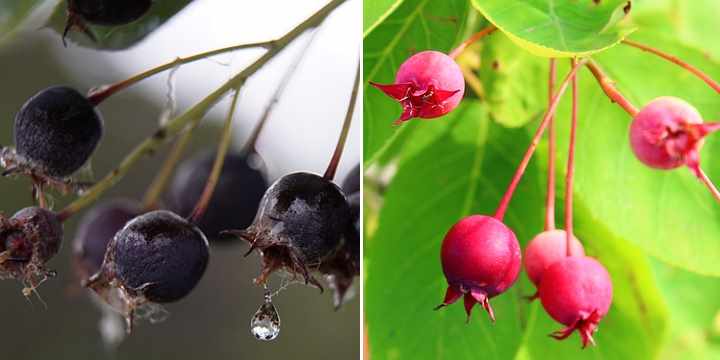
Serviceberry fruit. Left picture: mature purple serviceberry fruits. Right picture: immature red serviceberry fruits.
The trees grow 15 to 25 ft. (4.5 – 7.5 m) tall and wide and thrive in USDA zones 4 to 8.
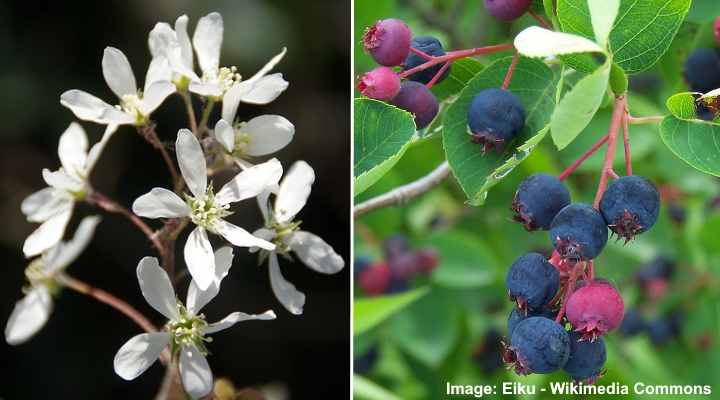
Juneberry flowers, fruit and leaves
Jamaica Cherry Tree (Muntingia calabura)
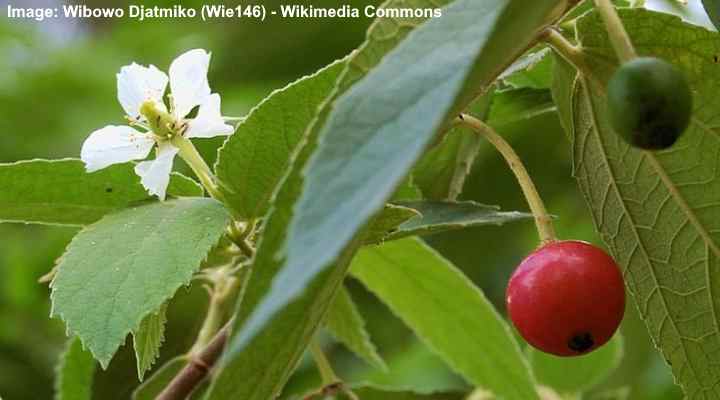
Jamaica cherry tree (Muntingia calabura)
The Jamaica cherry tree is a small evergreen tree with bright red berries that grows in tropical climates. It’s a fast-growing berry-producing tree with lanceolate leaves, white star-shaped flowers featuring prominent yellow stamens, and large, cherry-like red fruits. Jamaica cherry trees grow 30 to 40 ft. (9 – 12 m) tall.
Native to Central America and the Caribbean, the Jamaica cherry tree thrives in USDA zones 10 and 11. It has a spreading crown and drooping branches. The tree’s red fruits are sweet and juicy and are used to make jams and jellies.
Due to its dainty, papery flowers and berry-like fruits, the tree has several other common names. For example, it’s called the strawberry tree due to its white strawberry-like blooms. It also goes by the names cotton candy berry, jamfruit tree, and Panama berry tree.
Chokecherry Tree (Prunus virginiana)
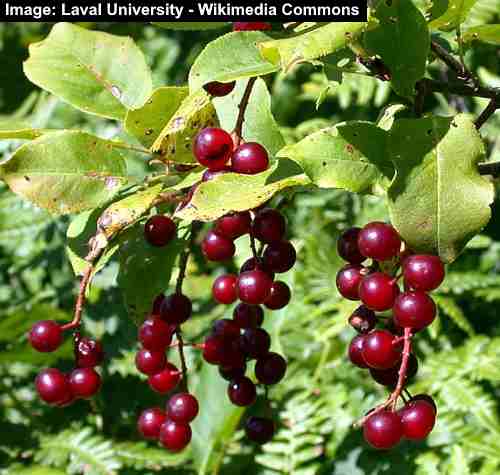
Chokecherry immature fruit is red and turns dark purple-black when mature
The chokecherry tree is a small perennial tree or multi-stemmed shrub producing abundant red berry-like drupes 0.5” (1.3 cm) in diameter. This suckering tree typically grows 3 to 20 ft. (1 – 6 m) tall, however it’s not unusual for some chokecherry trees to reach 30 ft. (9 m) tall. Other ornamental features include its large, cylindrical clusters of white cup-shaped flowers and oval leaves with serrated margins.
As its name suggests, these bright red to black fruits have a bitter, astringent taste that makes your face pucker. The red berries turn dark purple-black as they ripen during summer.
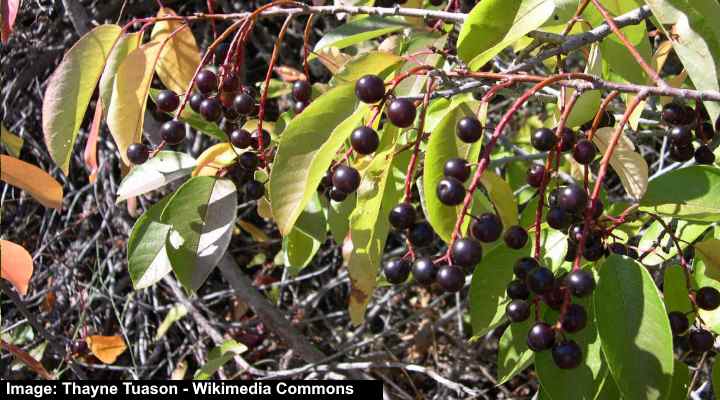
chokecherry mature fruit
The chokecherry tree’s rounded crown and spreading branches provide dense shade during the hot summer months. You can plant the small suckering tree in full sun and USDA zones 2 through 7 in dry to medium, well-draining soil.
Pacific Madrone Tree (Arbutus menziesii)

Fruit of Pacific madrone tree (Arbutus menziesii)
The spectacular Pacific madrone tree is characterized by its wide-spreading branches with clusters of bright orange-red berries in the fall. Native to the Pacific Northwest region of North America, this ornamental tree has exfoliating reddish-brown bark and dangling clusters of white, urn-shaped flowers followed by brightly colored scarlet berries.
The Pacific madrone tree grows 20 to 50 ft. (6 – 15 m) in height with a wide, rounded canopy the same size. Its interesting gnarled branches are covered in reddish-brown bark that peels off in strips. In warm, southern climates, this madrone species is one of the most attractive flowering evergreen trees with red berries.
Eastern Wahoo (Euonymus atropurpureus)
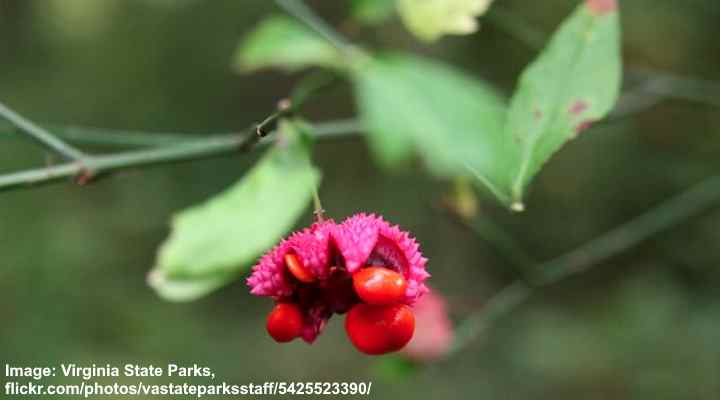
Eastern wahoo flower and berry-like red seed capsules
Ornamental red berries are an attractive feature of the eastern wahoo tree. This shrub-like small tree blooms in late spring and early summer with masses of tiny dark reddish-purple flowers. These develop into four-lobed crimson seed capsules which dangle on the tree throughout winter. During summer, lime-green leaves cover the tree before turning scarlet in the fall.
The eastern wahoo tree thrives in USDA zones 3 to 7, growing 12 to 20 ft. (3.6 – 6 m) tall with a spreading canopy 15 to 25 ft. (4.5 – 7.5 m) wide. Although you can grow this berry-producing tree in full shade, its best blooms and fruits occur in full sun.
Other names for the eastern wahoo include spindle tree and burning bush.
Common Hackberry (Celtis occidentalis)
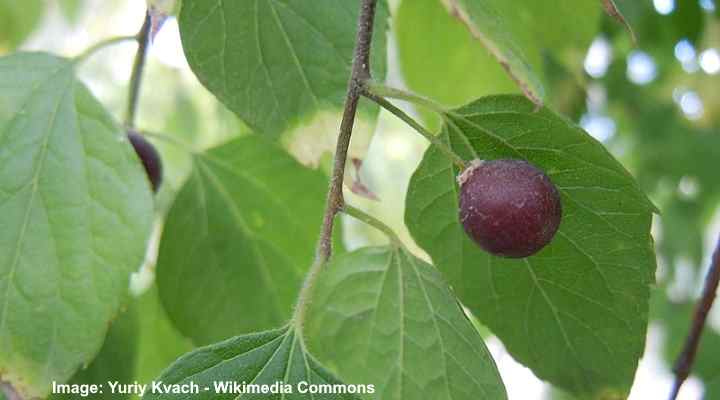
Fruit of common hackberry (Celtis occidentalis)
The common hackberry tree is a medium-sized deciduous tree known for its dark red to purple ball-shaped fruits 0.5” to 0.75” (1.3 – 2 cm) in diameter. The common hackberry is identified by its round crown with spreading branches, grayish-brown, deeply furrowed bark, and elm-like leaves. In springtime, small greenish-yellow flowers bloom, which give way to clusters of small fleshy berry-like dark red drupes.
Common hackberry trees thrive in full sun exposure or deep shade in USDA zones 3 to 9. The red berry trees prefer well-drained soil but can thrive in most soil types. The attractive ornamental trees grow 40 to 60 ft. (12 – 18 m) tall, making them ideal for shade gardens.
Gumbo-Limbo (Bursera simaruba)
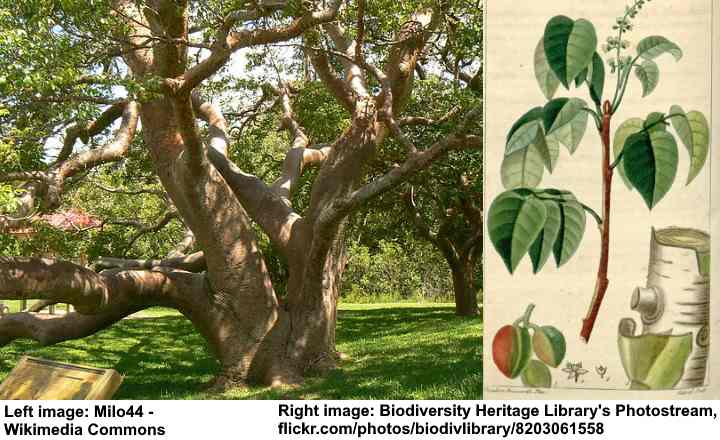
Gumbo-Limbo tree (Bursera simaruba) with berry illustration an the right image
Gumbo-limbo is a tropical tree easily identified by its unique peeling reddish bark and bright red diamond-shaped berries. This evergreen tree makes an eye-catching sight in a warm landscape. Its large spreading branches have orange to reddish brown bark that peels off in thin strips, leathery leaves, small yellowish-green flowering clusters, and red berries.
The ornamental red-barked tree grows 25 to 40 ft. (7.5 – 12 m) in USDA zones 10 and 11. It’s drought-tolerant and performs best in moist to dry soils with good drainage. Thanks to its dense foliage and spreading crown, gumbo-limbo makes for an excellent shade tree in South Florida.
Learn How to Identify Shrubs With Red Berries.
Related articles:
